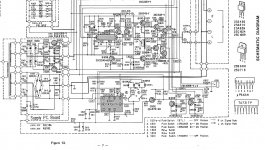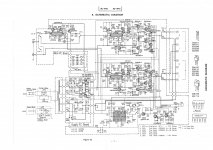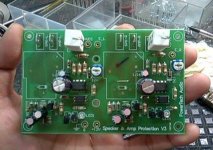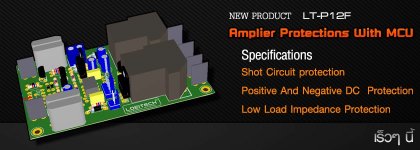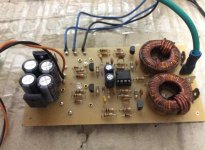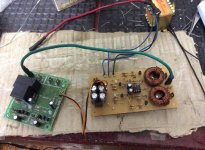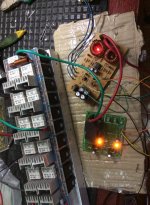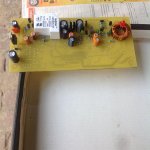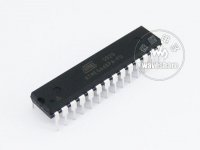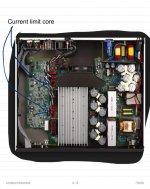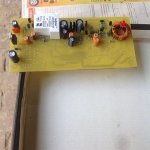Here is one working perfectly (this is my "service" amplifier getting shorts and DC input day-by day, not once let me down in the past few years... Overload protection activates at around 3-3.5 A Ic -with the 0.22 ohm emitter resistors, DC trips it at around 1.2-1.5V at the output.
Attachments
Hello dragonweed
greetings thanks for sending schematic can you give link to schematic or post bigger schematic little to small for my weak eyes
warm regards
Andrew
greetings thanks for sending schematic can you give link to schematic or post bigger schematic little to small for my weak eyes
warm regards
Andrew
Here is one working perfectly (this is my "service" amplifier getting shorts and DC input day-by day, not once let me down in the past few years... Overload protection activates at around 3-3.5 A Ic -with the 0.22 ohm emitter resistors, DC trips it at around 1.2-1.5V at the output.
And does this overcurrent protection circuit periodically switch relay on/off, like oscilating?
I think when short condition happened IC will broke off relay and disconect shorted outputs , but because outputs are still shorted after relay broke off it will broke on again and that would happened periodically
1.Re voltage rise when short circuit happends -relay broke off
2.Re voltage drops because relay broke off and relay now broke on
3.Re voltage rise because output are still phisicaly shorted and relay broke off
and this is happening periodicaly
speaker protection
https://www.youtube.com/watch?v=U2onAUUCHGM&feature=youtu.be
simple DC protector with short circuit protection😉
https://www.youtube.com/watch?v=U2onAUUCHGM&feature=youtu.be
simple DC protector with short circuit protection😉
Attachments
short circuit protection
Hello
greetings has anyone tried QSC PL380 over current protection maybe it
can be used with other amplifers as short circuit protection
warm regards
Andrew😉
Hello
greetings has anyone tried QSC PL380 over current protection maybe it
can be used with other amplifers as short circuit protection
warm regards
Andrew😉
Attachments
An electromechanic relay may be fast enough to protect the coil of a speaker.
But, its response time is too long to protect a semiconductor device such as transistors.
The best device to protect a transistor would be a transistor switch connected in series with the DC power line.
But, its response time is too long to protect a semiconductor device such as transistors.
The best device to protect a transistor would be a transistor switch connected in series with the DC power line.
A current limiter in the supply rails can be made to work very well.
This can be done in several ways.
hard current limit
rentrant current limit.
different transient current and DC current limits.
A high current low Rdson mosFET triggered by a (filtered for transients) current detector is probably the simplest. Some are shown in this Forum.
Once you have that working, then you may find that only two more devices are needed to complete the protection.
A close rated fuse feeding the mains transformer
A heatsink temperature switch to trigger the mains supply
This can be done in several ways.
hard current limit
rentrant current limit.
different transient current and DC current limits.
A high current low Rdson mosFET triggered by a (filtered for transients) current detector is probably the simplest. Some are shown in this Forum.
Once you have that working, then you may find that only two more devices are needed to complete the protection.
A close rated fuse feeding the mains transformer
A heatsink temperature switch to trigger the mains supply
Last edited:
Hello
greetings everyone yes solidstate relays are much faster and from esperados ultimate
short circuit protection the mosfet relay will be used another option current hall
sensors ACS712 30A or 50A to be used for overload short circuit protection idea
already provided by a kind gentleman of this forums ics have not arrived for me
to try it
warm regards
Andrew
greetings everyone yes solidstate relays are much faster and from esperados ultimate
short circuit protection the mosfet relay will be used another option current hall
sensors ACS712 30A or 50A to be used for overload short circuit protection idea
already provided by a kind gentleman of this forums ics have not arrived for me
to try it
warm regards
Andrew
short circuit protection
Hello
greetings maybe MCU be the answer to short circuit protection and low
impedance detector
warm regards
Andrew😉
Hello
greetings maybe MCU be the answer to short circuit protection and low
impedance detector
warm regards
Andrew😉
Attachments
Hello
greetings maybe MCU be the answer to short circuit protection and low
impedance detector
warm regards
Andrew😉
Try a MCU and hall effect switch to measure current.
short circuit protection
https://www.facebook.com/permalink...._close_friend=1¬if_t=close_friend_activity
Hello
greetings finished short circuit and dc protection and low impedance
detector QSC PL380 overload schematic😉
https://www.facebook.com/permalink...._close_friend=1¬if_t=close_friend_activity
Hello
greetings finished short circuit and dc protection and low impedance
detector QSC PL380 overload schematic😉
Attachments
- Home
- Amplifiers
- Solid State
- diy short circuit protection
